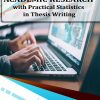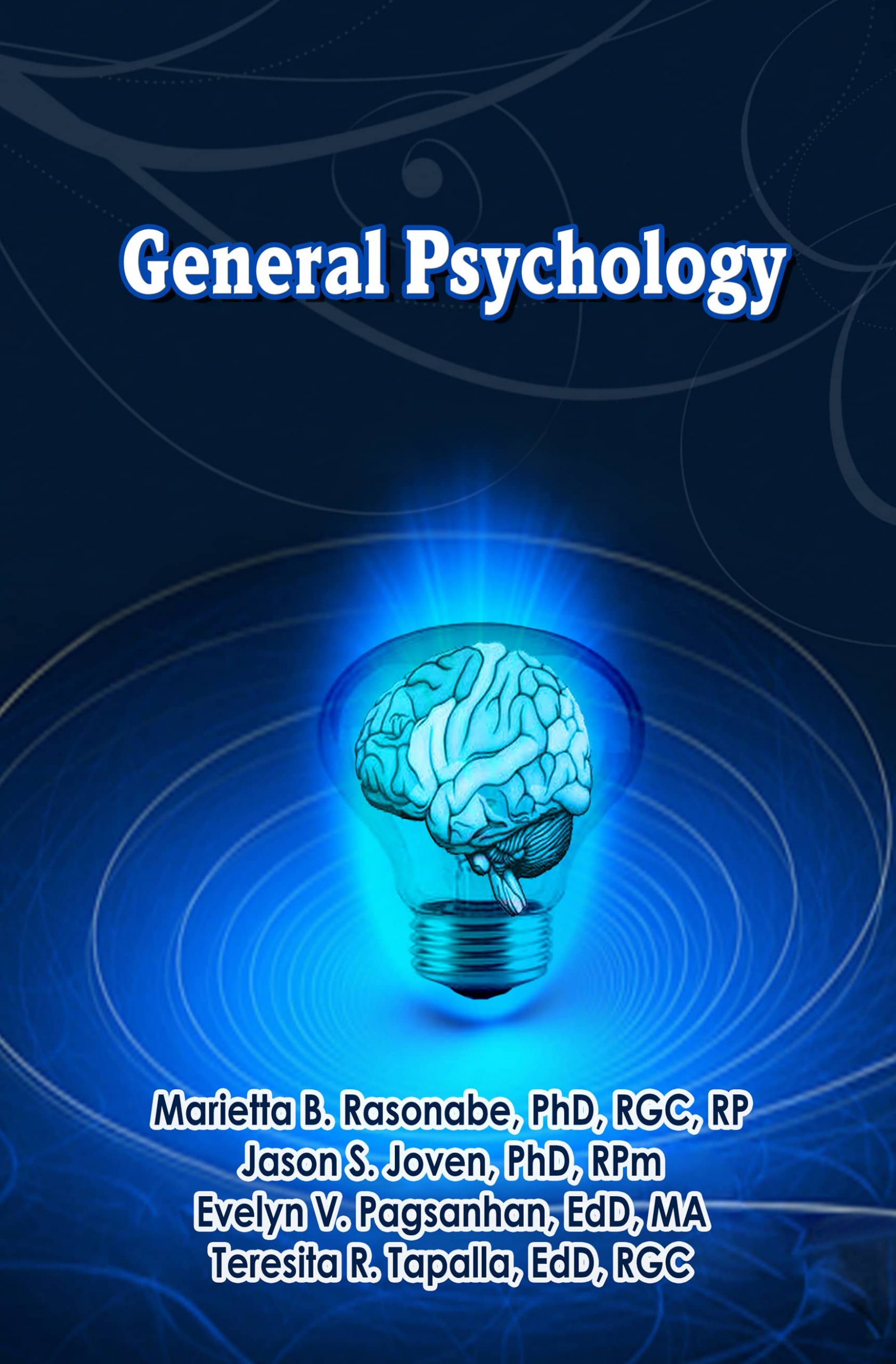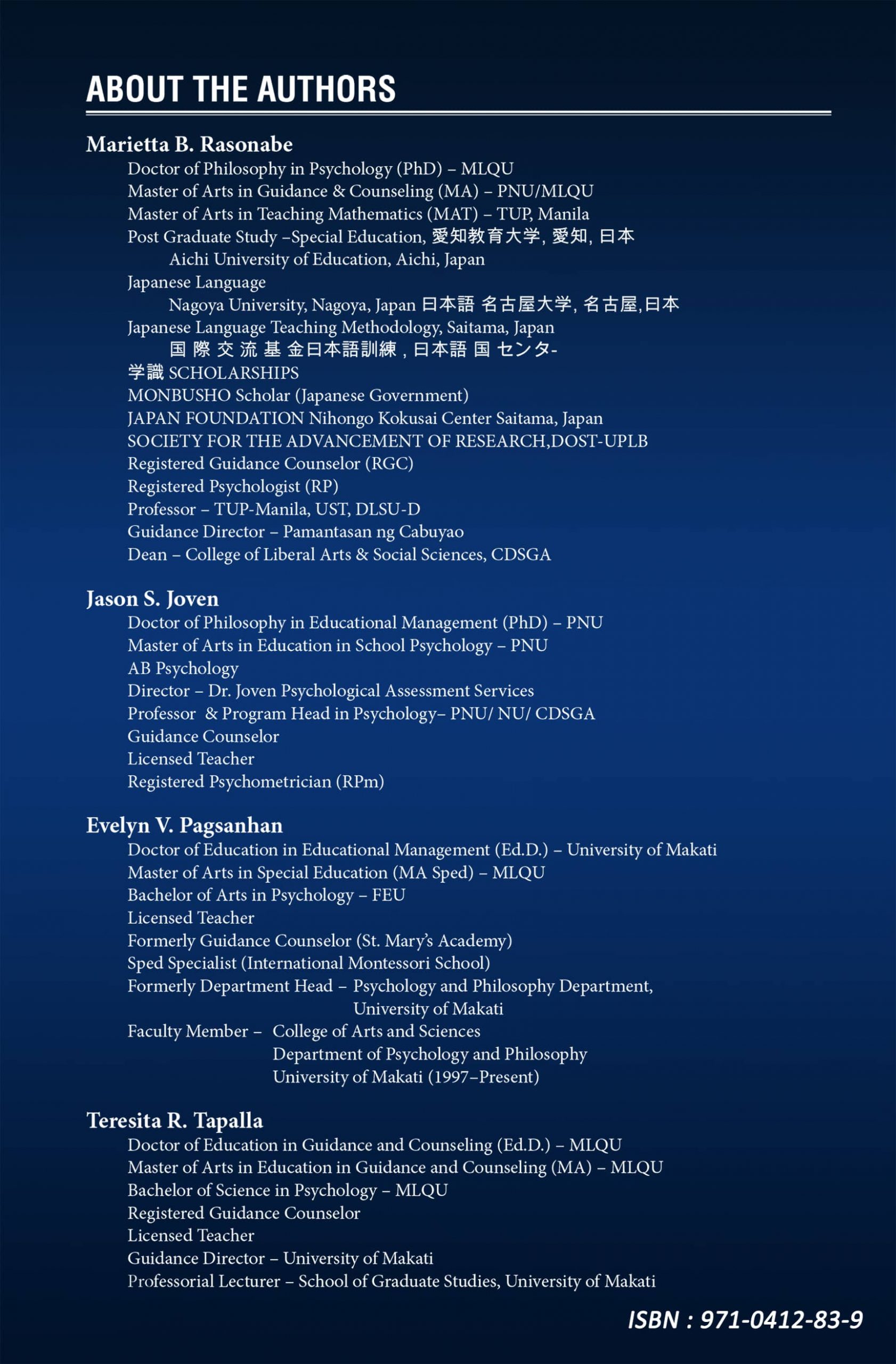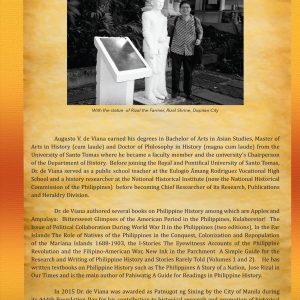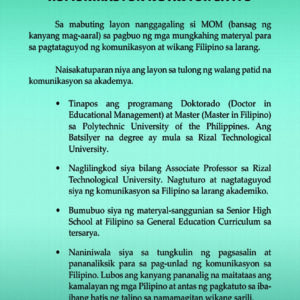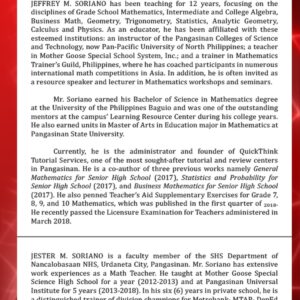General Psychology
₱275.00
ISBN: 971-0412-83-9
Author: Marietta B. Rasonabe, PhD, RGC, RP
Jason S. Joven, PhD, RPm
Evelyn V. Pagsanhan, Ed.D, MA
Teresita R. Tapalla, Ed.D, RGC
Description
ISBN: 971-0412-83-9
Author: Marietta B. Rasonabe, PhD, RGC, RP
Jason S. Joven, PhD, RPm
Evelyn V. Pagsanhan, Ed.D, MA
Teresita R. Tapalla, Ed.D, RGC
Psychology is a meeting ground of different disciplines. It teaches us
how to think critically as we read the different ideas and apply them in our
daily lives.
Although most psychology books focus on methods and results of
psychological science, there are also those devoted to practical issues such
as how to overcome depression or anxiety.
As a science, the aim of this book is to sift opinion and to evaluate ideas
with careful observation and analysis. One of its quests is to explain the
nature-nurture issue and to weigh sound theories.
Once we are aware of psychology’s ideas – how body and mind connect,
how we construct perceptions, how people across the world differ – our
life’s perspectives may never be the same again.
Additional information
| Book Type | Hard Copy, e-book |
|---|
Table of Contents
Table of Contents
Psychology’s Current Perspective………………………………………………… 3
Psychology’s Subfields…………………………………………………………………. 4
Psychology’s Big Issue/Studying Psychology……………………………….. 5
Summary of Terms and Concepts/Exercises……………………………….. 6
Chapter 1 Critical Thinking…………………………………………… 7
Scientific Attitude………………………………………………… 8
The Limits of Intuition and Common Sense………… 8
The Scientific Method………………………………………….. 9
Research Strategies………………………………………………. 11
Summing Up (The Scientific Method)…………………. 14
Summary of Terms/Common Facts
about Psychology…………………………………………….. 15
Exercises (A and B)……………………………………………… 19
Summative Test No. 1………………………………………….. 21
Chapter 2 Neuron, Genetics and Behavior………………………. 23
The Nervous System……………………………………………. 24
The Neuron (Basic Units of the Nervous System)… 25
Nerves and Synapses……………………………………………. 27
Brain……………………………………………………………………. 28
The Limbic System………………………………………………. 31
Genes………………………………………………………………….. 31
Behavior Genetics……………………………………………….. 32
Nature and Nurture Issue…………………………………….. 33
Molecular Genetics……………………………………………… 34
Summing Up……………………………………………………….. 35
Exercises …………………………………………………………….. 36
Summative Test No. 2………………………………………….. 37
Chapter 3 Human Development…………………………………….. 39
Prenatal/Neonatal……………………………………………….. 40
Physical Development/Brain Reorganization………. 41
Motor/Cognitive Development……………………………. 42
Piaget’s Stages of Cognitive Development……………. 43
Social Development…………………………………………….. 44
Erickson’s Stages of Psychosocial Development……. 49
Summary/Summing Up………………………………………. 52
Exercises……………………………………………………………… 54
Summative Test No. 3………………………………………….. 55
Chapter 4 Sensation………………………………………………………. 57
The Basic Principle/Absolute Thresholds…………….. 58
Difference Threshold/Sensory Adaptation…………… 59
Vision………………………………………………………………….. 60
Color Vision/Hearing/The Ear…………………………….. 62
Other Senses……………………………………………………….. 63
Summing Up……………………………………………………….. 64
Exercises……………………………………………………………… 65
Summative Test No. 4………………………………………….. 67
Chapter 5 Perception…………………………………………………….. 69
Perceptual Organization………………………………………. 71
Shape and Size Constancy……………………………………. 74
Schemas………………………………………………………………. 75
Summing Up……………………………………………………….. 76
Exercises……………………………………………………………… 78
Summative Test No. 5………………………………………….. 79
Chapter 6 Consciousness……………………………………………….. 81
Day Dreams and Fantasies…………………………………… 83
Why Do We Sleep?………………………………………………. 84
Sleep Disorder…………………………………………………….. 85
Why Do We Dream?……………………………………………. 86
Can Hypnosis be Therapeutic?…………………………….. 87
Summing Up……………………………………………………….. 88
Exercises……………………………………………………………… 89
Summative Test No. 6………………………………………….. 91
Chapter 7 Learning……………………………………………………….. 93
Associative Learning……………………………………………. 94
Conditioning………………………………………………………. 95
Comparison of Classical and
Operant Conditioning…………………………………….. 105
Learning by Observation…………………………………….. 106
Summing Up……………………………………………………….. 107
Exercises……………………………………………………………… 108
Summative Test No. 7………………………………………….. 109
Chapter 8 Memory………………………………………………………… 111
Automatic/Effortful…………………………………………….. 113
Types of Encoding……………………………………………….. 114
Chunking/Hierarchies…………………………………………. 115
Encoding Failure…………………………………………………. 116
Short/Long Term Memory Storage………………………. 117
Storing Implicit and Explicit Memory…………………. 118
Moods and Memories………………………………………….. 119
Interference…………………………………………………………. 120
Memory Construction…………………………………………. 121
Summing Up……………………………………………………….. 123
Exercises……………………………………………………………… 124
Summative Test No. 8………………………………………….. 125
Chapter 9 Thinking and Language………………………………….. 127
Thinking/Obstacles to Problem Solving………………. 128
Making Decision and Forming Judgments…………… 129
The Availability Heuristic…………………………………….. 130
Simulating Thinking: Artificial Intelligence…………. 132
Language Structure……………………………………………… 133
Explaining Language Development……………………… 134
Summing Up……………………………………………………….. 137
Exercises……………………………………………………………… 138
Summative Test No. 9………………………………………….. 139
Chapter 10 Intelligence……………………………………………………. 141
The Origin of Intelligence Test…………………………….. 142
Contemporary Theories of Multiple Intelligences… 145
Assessing Intelligence………………………………………….. 146
Principles of Test Construction……………………………. 147
The Dynamics of Intelligence………………………………. 148
Mental Retardation……………………………………………… 149
Components of Creativity……………………………………. 150
Genetic Influences……………………………………………….. 151
Group Differences in Intelligence Test Scores………. 151
Summing Up……………………………………………………….. 151
Exercises……………………………………………………………… 152
Summative Test No. 10………………………………………… 153
Chapter 11 Motivation…………………………………………………….. 155
Maslow’s Hierarchy of Needs……………………………….. 157
Culture and Hunger/Sexual Motivation……………….. 158
Achievement Motivation……………………………………… 160
Intrinsic/Extrinsic Motivation……………………………… 160
Theory X and Theory Y……………………………………….. 161
Summing Up……………………………………………………….. 162
Exercises……………………………………………………………… 163
Summative Test No. 11………………………………………… 165
Chapter 12 Emotion……………………………………………………….. 167
The Physiology of Emotion………………………………….. 168
Emotional Arousal………………………………………………. 169
Physiological States Accompanying Emotions……… 170
Smiles as Indicators of Emotions…………………………. 171
Culture and Nonverbal Expressions…………………….. 171
Experiencing Emotions……………………………………….. 172
The Catharsis Hypothesis…………………………………….. 173
Happiness……………………………………………………………. 174
Subjective Well-being………………………………………….. 174
The Adaptation-Level Principle…………………………… 175
The Relative Deprivation Principle………………………. 175
Predictors of Happiness……………………………………….. 176
Theories of Emotions…………………………………………… 176
James-Lange Theory……………………………………………. 177
Two-Factor Theory……………………………………………… 178
Must Cognition Precede Emotion?……………………… 178
Summing Up……………………………………………………….. 179
Exercises……………………………………………………………… 180
Summative Test No. 12………………………………………… 183
Chapter 13 Personality……………………………………………………. 185
The Psychoanalytic Perspective……………………………. 186
Personality Structure…………………………………………… 187
Freud’s Psychosexual Stages…………………………………. 187
Assessing the Unconscious………………………………….. 188
Two Personality Factors………………………………………. 189
The Big Five Personality Factor by Hans Eysenk….. 189
Assessing Traits…………………………………………………… 190
Value Contrasts between Individualism
and Collectivism……………………………………………… 192
The Social Cognitive Perspective…………………………. 192
Exploring Behavior in Situations…………………………. 193
The Four Perspective of Personality…………………….. 195
Personality Disorder……………………………………………. 196
Summing Up……………………………………………………….. 200
Exercises……………………………………………………………… 202
Summative Test No. 13………………………………………… 203
Chapter 14 Stress and Health…………………………………………… 205
Stress…………………………………………………………………… 206
Stressors………………………………………………………………. 207
Stress and Personality Types………………………………… 208
Negative Emotions………………………………………………. 209
Promoting Health……………………………………………….. 209
Meditation…………………………………………………………… 211
Stress and Resistance to Disease………………………….. 212
Stress and the Immune System…………………………….. 212
Summing Up……………………………………………………….. 212
Exercises……………………………………………………………… 214
Summative Test No. 14………………………………………… 215
Glossary …………………………………………………………………………………….. 217
Bibliography ……………………………………………………………………………… 237
Index………………………………………………………………………………………….. 241
